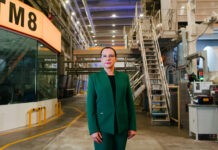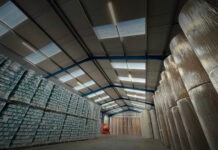By Milltech’s Luca Linari and Marco Cattani
With increasing regulation the attention paid by mills to the phenomenon of “noise” has increased
Noise has two distinct impacts in a tissue mill: the effect on the operator’s work and wellbeing, and the impact on the mill’s neighbours. Both are regulated by legislation which varies from country to country, but has in all cases become increasingly stringent and complex.
The approaches commonly used to manage the noise experienced by mill staff are design and encapsulation. You can design the machine and choose components to ensure operation is as quiet as possible. Where practical, you can confine certain machines or components within soundproof cabinets. But the need for the operator to access the line, and the general ergonomics of the machine mean this is not always possible, and direct ear protection is the most suitable solution.
Emissions outside the mill are a different story. Where mills are based in towns, or close to individual houses, as is frequently the case with tissue mills, then noise emission becomes a critical factor in mill design. Air systems, steam plants, ventilation systems and dust extraction are all essential elements of a tissue mill which can cause noise problems if not designed and installed with noise levels in mind.
Tissue mills are often sited in towns as the scale of tissue production operations often still fits an original urban setting. Rebuilds are therefore a particular case-in-point when it comes to noise abatement, unlike new lines which are more likely to be constructed out of town. The physical constraints of an existing building rather than a new site also means it is frequently impossible to house some of the major sources of noise, such as the heat recovery unit, within the machine building.
“The measurement of noise really is quite a precise science and the need to tailor a technical solution for the customer is important today in a way it just was not before.”
According to most common standards, the noise limit acceptable for daytime is about 65dB (A), for night-55dB (A). For mills sited in residential areas that limit can fall below 45dB (A). Also, some situations are regarded as “different” and involve even higher or lower limits as a consequence, so the technical solutions to noise need to be calculated caseby- case.
From a technical viewpoint, the approach to noise emission has changed much over time. In the early years the focus was on a “single” noise emission source and the need to bring it to a limit determined by local zoning communicated by the mill or by contract. But such technical evaluation has limitations because regulators measure noise emission at the homes affected, or at the mill’s boundaries, and contractual agreements of noise emission tend to be drawn up case-by-case anyway.
In any event, it is the logarithmic sum of all noise emissions outside the mill which counts, rather than a figure based on an individual source. The measurement of noise really is quite a precise science and the need to tailor a technical solution for the customer is important today in a way it just was not before.
For example, during an air system or dust system rebuild, the size of silencer specified will depend on the layout of the mill and the distance from the point of emission to the mill boundary or to the nearest houses and, of course, the local noise limits. In most cases, noise reduction of the order of 20dB is adequate. But we have worked on cases where a reduction of up to 48dB is required, which is a different matter altogether.
Silencer design itself has had to keep pace with regulation, and alternatives to rockwool as a sound dampener have had to be found due to health and safety issues. Mills also have the choice between cylindrical designs and rectangular (cylindrical and rectangular designs). Cylindrical causes less pressure loss and is therefore more energy efficient. A cylinder is less compact to fit than a rectangular shape, of course, so this has to be part of the equation and design.

Another example where design needs to take account of noise is the sizing of an exhaust fan. Where noise reduction is paramount, the fan needs to rotate more slowly, but to maintain performance, it will need to be bigger, which needs to be considered right at the outset of a project. Another example where noise reduction can be achieved is the use of elastic pads to support ductwork rather than rigid fixtures where ductwork needs to be placed outside.
In most cases it is essential to use noise calculation software which allows simulations to estimate the residual noise at a certain point in the plant (or to the nearest houses), which is agreed for each project with the final customer. Whatever the situation, a preliminary study is essential.
































